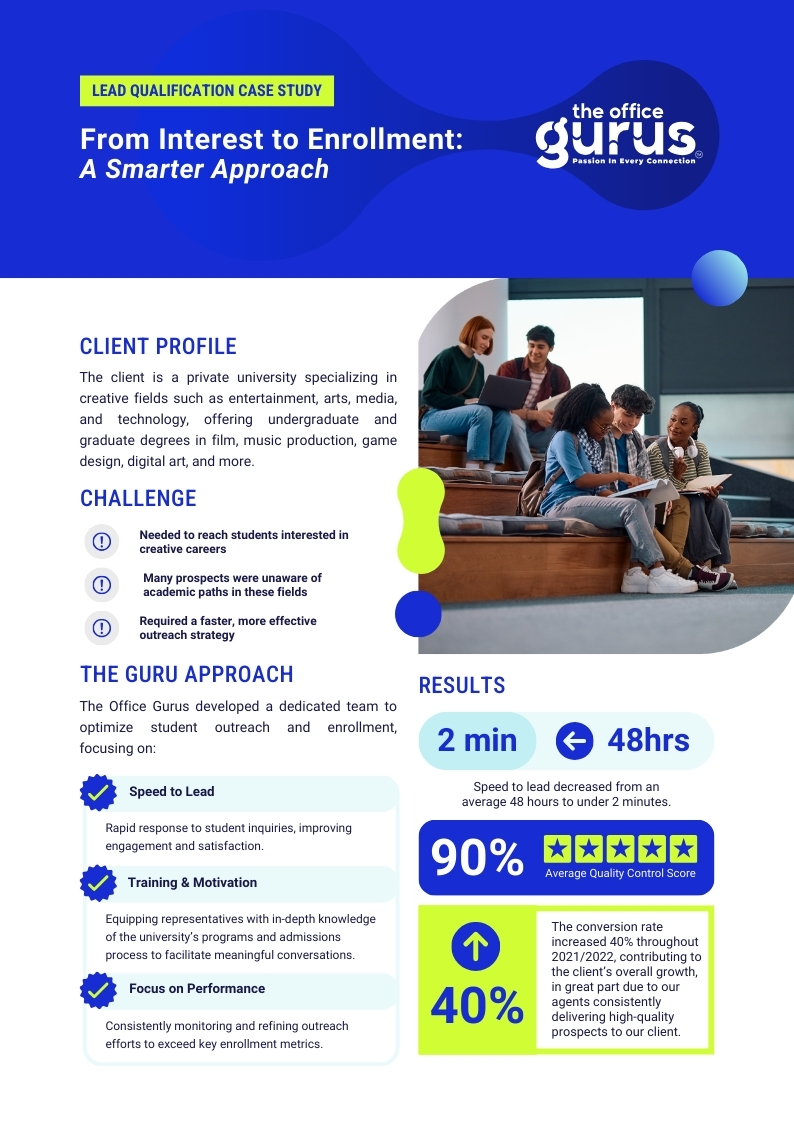A student in São Paulo finishes dinner and opens her phone to ask about scholarships at a U.S. design school. Two time zones later, a family in Seoul wants details for their student moving into a dorm, and they want them now, not tomorrow. Institutions that rely solely on daytime campus staff risk losing these prospects to universities that can answer in Portuguese, Korean, or Spanish while the question is still fresh in their mind.
A multilingual contact‑center partnership bridges this gap, delivering guidance around the clock that feels local. Below, we break down four pillars of effective global outreach, then unpack a real‑world case study that shows just how fast trust (and conversions) can climb when you get the language and timing right.
1 | Speak the Right Language on the First Hello
Parents and students evaluating a school abroad weigh visa hurdles, tuition, and culture shock. Greeting them in their native tongue signals empathy before any policy is explained. That’s why universities often staff language‑specific queues routed through an education‑specialized support desk.
- Local idioms matter. Saying “Boa tarde” instead of a generic “Hello” instantly lowers anxiety for Portuguese speakers.
- Translated knowledge bases let chatbots deflect basics, such as application deadlines and credential uploads, without misusing machine translation.
2 | Blend Live Agents With Smart Self‑Service
Chatbots can handle document checklists at 3 a.m. while seasoned advisors tackle more complex issues like financing and housing. A unified inbound + outbound workflow keeps context intact so a prospect never re‑explains their TOEFL (Test of English as a Foreign Language) score. Escalation rules trigger a live agent to call back whenever the bot detects emotional cues like “worried” or “urgent.”
3 | Build Credibility With Region‑Specific Success Stories
Nothing calms nerves like hearing from someone “just like you.” Admissions teams create micro‑case studies: “How Priya from Mumbai secured a campus job in week one.” Agents weave these stories into calls, a tactic drawn from our broader approach to creating a customer‑centric organization.
4 | Protect Data Across Borders
FERPA, GDPR, and country‑specific privacy laws overlap in complex ways. Outreach desks anchored to a hardened security‑compliance framework encrypt transcripts end‑to‑end and apply role‑based access, giving families confidence that passports and transcripts won’t leak.
Case Study: From Interest to Enrollment in Under Two Minutes

Key Wins
- Speed‑to‑lead dropped from 48 hours to 2 minutes, keeping the school fresh in their mind.
- Average quality‑control score: 90%+ across Spanish, Portuguese, and English queues.
- 40% jump in conversion rate year‑over‑year, fueled by culturally fluent outreach.
The university, specializing in creative arts, partnered with The Office Gurus to build a multilingual team. Agents trained on program specifics and local education systems (e.g., Brazilian ENEM scores vs. U.S. SAT). Combined with rapid follow‑up, the school’s enrollment pipeline expanded while marketing spend stayed flat.
Metrics That Matter
| KPI | Pre‑Outreach Revamp | Six Months Later |
| First‑Contact Resolution | 78% | 91% |
| Applications Started Within 24 h of Inquiry | 45% | 67% |
| Parent CSAT (5‑pt scale) | 4.0 | 4.7 |
Continuous agent coaching, similar to our talent‑development blueprint, kept these gains climbing even as new source markets came onboard.
Quick‑Start Checklist for Global Admissions Teams
- Audit language demand by lead source; launch dedicated queues for top three markets.
- Localize FAQs: currency converters, embassy wait times, health insurance tips.
- Integrate chat transcripts with CRM; set triggers to automatically dial unanswered high‑intent leads.
- Schedule quarterly QA calibrations with in‑country alumni to refine cultural nuance.
- Track scholarship acceptance vs. inquiry language to prove ROI on multilingual staffing.
Final Takeaway
International students choose schools that feel welcoming before they book a flight. Multilingual outreach, powered by data‑savvy, culturally fluent contact‑center teams, builds that sense of belonging in the very first interaction. When the acceptance letter arrives, enrollment is no longer a leap of faith; it is the next logical step in a relationship already grounded in trust.
Ready to build stronger connections with international students before they arrive? Let’s talk.



